Is blogging helping you to meet your business goals?
While you may understand the value of content marketing, maybe it isn’t obvious how to track the performance and results of your blogging. Creating content to grow your business is only part of the task. Now you need to verify that your content is actually working.
As my dad always says, what isn’t inspected isn’t respected! You need to analyze whether or not your blogging is helping your business meet its goals.
Analysis helps to identify:
- what’s working
- what’s not working
- where improvements are needed
With this in mind, it’s not a big surprise that four out of five B2B marketers measure content performance (per Content Marketing Institute. July 22).
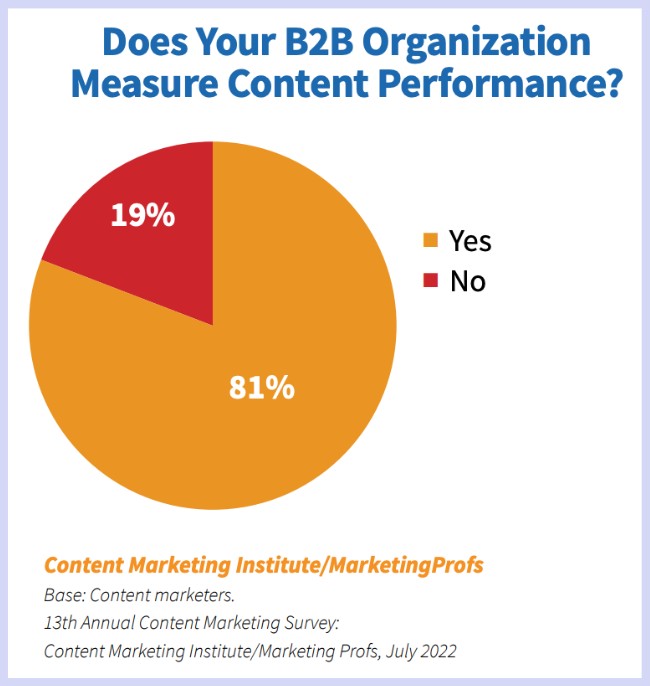
Content marketing metrics can be both formal and informal, but the key is knowing what metrics indicate success for your business. If you’re wondering about the ROI (return of investment) of blogging, tracking your content marketing metrics can help!
Of course, the definition of success varies because not every business has the same goals.
All in all, though, there are common metrics that you can use to assess whether your blogging is effective at supporting your small business. And, I’m sharing nine of them in this post.
But first…
What are Content Marketing Metrics?
Content marketing metrics are measurable indicators that help you determine whether your content is supporting the business blogging goals and objectives you’ve set.
To gauge how your content is performing, you track, assess, and analyze these indicators to guide your content strategy.
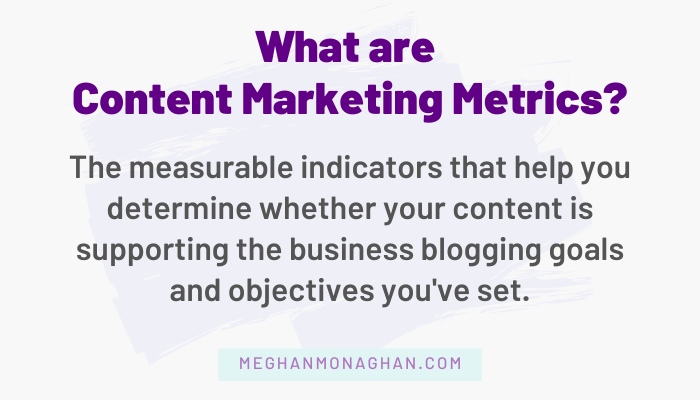
Without identifying goals and metrics, assessing your content’s performance will be difficult.
Now let’s talk about some of the metrics that will help you analyze your own blogging efforts.
1) Website Traffic
When your blog content is resonating with your audience and getting more visibility, typically more people will visit your website. This is called “website traffic.” And, more traffic can lead to more leads and sales. So, it makes sense that website traffic is one metric commonly used to track performance.
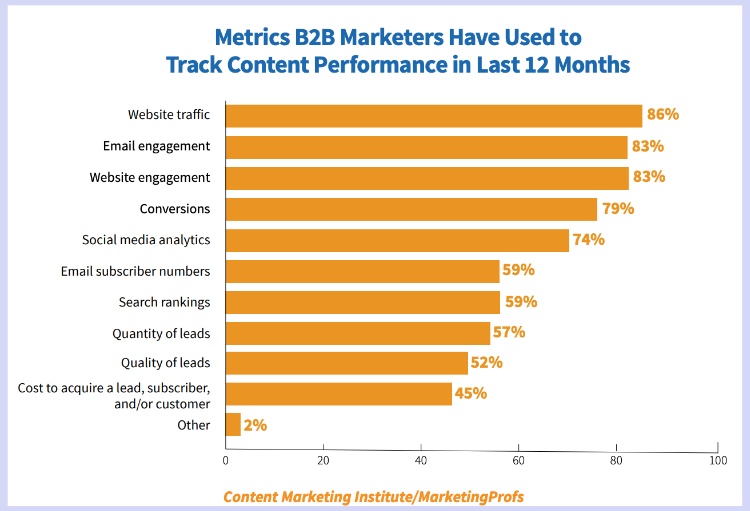
A website with high quality, search-optimized, and strategic content means you’ve put a plan in place to attract a target audience. However, more traffic doesn’t always equal more website conversions. For this reason, I recommend that you don’t use website traffic as a standalone metric. Combine it with other analytics to get a well-rounded view of your content marketing.
To find out your monthly traffic, use Google Analytics* and Google Search Console. Both are free, easy, robust tools to see how people interact with your content. In many cases, you can even see where that traffic is coming from, what pages are most popular, and where people go after they enter your site.
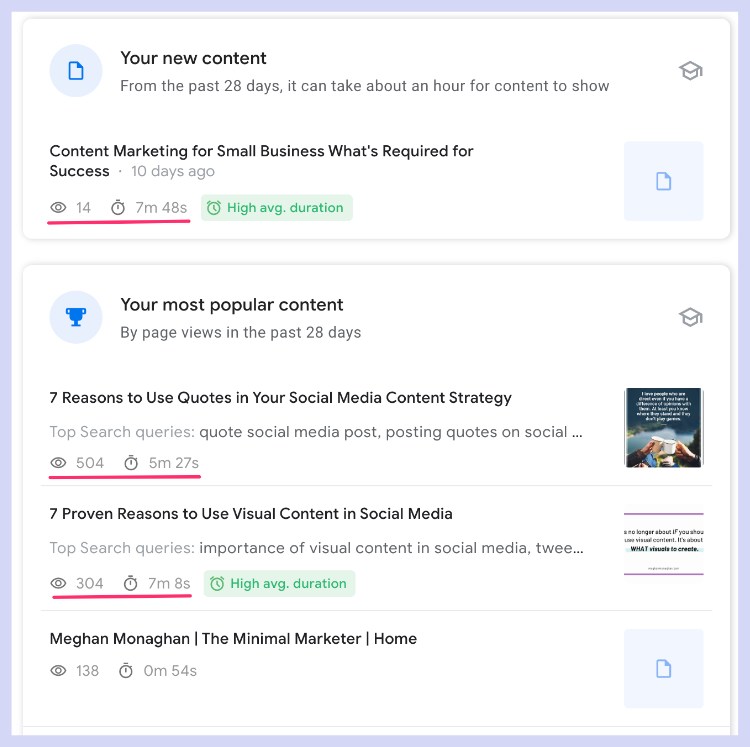
*Unfortunately, Google Analytics is changing! The new GA4 is scheduled to be forced upon us around June/July 2023. Apparently, GA4 isn’t as intuitive and doesn’t offer the same data in a plug and play setup like now.
2) User Engagement and Behavior
How people interact with your content is some of the coolest, most interesting data that Google Analytics and Google Search Console collect and share. The geek in me loves this!
You can gather a lot of intel by seeing what website visitors do after they arrive at your site. Do they quickly leave (aka bounce), do they visit more than one page, and what pages do they look at?
Some of my favorite user engagement and behavior metrics are:
- Average time on page
- Average session duration
- Pages per session
- Behavior flow
- New and returning visitors
These more advanced statistics do a better job at analyzing your content’s performance than website traffic alone. Traffic data tells you that you have had visitors on your site. Yet, it doesn’t provide the complete picture of what those visitors did or whether they are likely to be valuable leads or not.

By looking at more advanced data, you can measure the effectiveness of specific content. For example, if you’re seeing five minutes as the average time on a page for a blog post, then you could extrapolate that users consumed the majority of the content and likely found it valuable.
More page views and longer page time means that your website visitors are digging your content. Plus, the longer visitors hang around and browse your content, the more Google will favor your site.

Tracking internal links to other pages and opt-in forms allows you to combine further data sets. You can see how many of those readers went on to view more pages, what pages they viewed, and if they opted in for freebies. (However, setting up conversion tracking is more complex than simply reviewing the existing data.)
Social Shares
Another one of the content engagement metrics you can use to determine what people think about your blog posts is social shares. The more social media shares of a piece of content may signify that the topic resonates with people.
Therefore, if you use a social sharing app on your website or you have a tool that tracks shares, then it’s possible to monitor how many shares a blog post or page receives.

In my opinion, social shares aren’t that helpful as a content marketing metric. That doesn’t mean shares are a vanity metric. However, do social media shares correlate with a tangible, meaningful goal? After all, a blog post with few shares may still perform well in terms of meeting your goals.
Also, the sharing of blog posts has declined some and social media platforms show link posts less. So, more or less shares may not be an accurate indicator of how people feel about your content. But, it depends on your niche and business goals!
3) Keyword Ranking
Your blog posts’ phrases and terms—aka keywords—help people find your website when they do an online search. When your content ranks high for a particular keyword, it indicates that your blog content is relevant and valuable to users searching for that keyword. This can result in increased traffic to your website, which can lead to higher conversions and ultimately, more revenue.
So, keyword ranking is one way to measure the effectiveness of your content in attracting traffic from search engines.
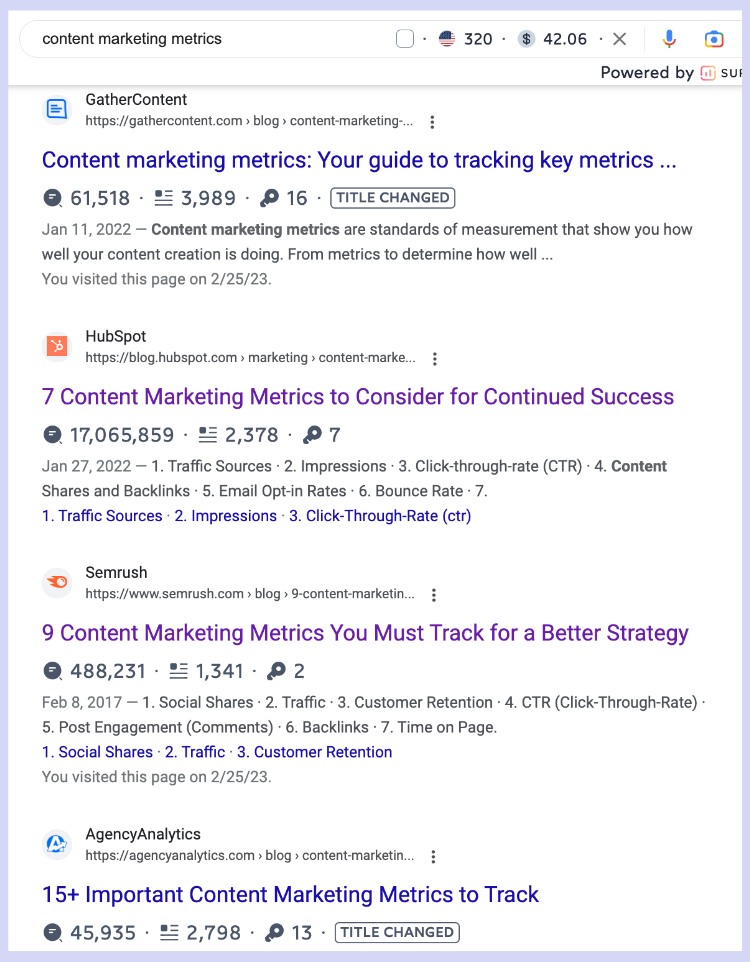
Obviously, if your post ranks on page one in the SERPs, then you have a higher chance of your target audience seeing, clicking, and reading it. The farther down in the SERPs that your post ranks for a keyword, then the less effective your content is. At least, in theory.
The thing is, keywords aren’t always the best indicator of good content! There are plenty of times that your post ranks in the top 5 for a keyword, but that keyword doesn’t attract traffic or conversions. If no one is clicking on your post, then who cares if it’s a top 10 keyword?! Thus, ranking doesn’t always equate to better content performance.
Top Pages
What’s more difficult is knowing which keywords to target to generate more leads and sales.
That’s why I also look at the metrics of top pages too. The pages that people visit the most represent what people are interested in and actually clicking on.

Keywords don’t always attract people (ie traffic), but your landing pages ARE attracting visitors. So, check out which blog posts are also top landing pages.
Besides Google’s tools, there’s no shortage of free and paid tools to review your keyword rankings.
4) Lead Generation
Lead generation is another content marketing metric to track because it measures the effectiveness of your blog in attracting potential customers and converting them into leads. This information can help you optimize your content strategy to improve your lead quantity and quality.
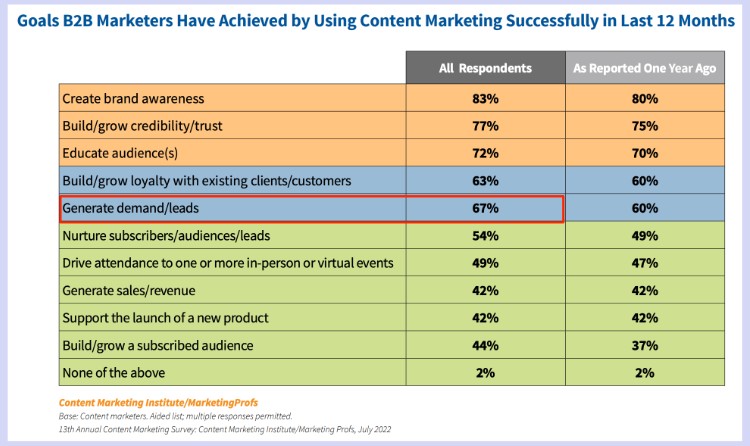
The ultimate goal of lead generation is to increase sales, which is why this metric is more aligned with sales. Furthermore, if you know how many leads turn into sales (aka your conversion rate), then having a site that generates qualified leads consistently is like turning on the sales machine.
For example, a 10% conversion rate means that you need 250 leads per month from your site to get 25 sales.
So, tracking this metric does a good job in determining whether blogging is making a difference to your bottom line. After all, you can have a million website visitors a month and rank number one for 150 keywords, but if those metrics don’t equate with qualified leads, then your blogging isn’t helping you acquire more customers.
Admittedly, it is more effort to track lead generation, which makes it a content marketing metric that isn’t as popular for small teams on tight budgets.
Leads are also important since a high percentage of website visitors will never return. Ouch! That’s why having a blog that converts visitors into qualified leads is a powerful tool for you.
5) Email List Growth
One of the simplest content marketing measurements can come in the form of your email list subscribers.
Although email list growth is a subset of lead generation, it’s an easier and less ambiguous metric to track. It’s straightforward: is your blog content attracting the right people and converting them into email subscribers?

If you’re creating content that is relevant to your business and your target market, your list should grow, signifying that your blogging is working.
Email marketing itself can nurture interested people and turn them into buyers. But, another benefit of having an engaged email list is that you can drive more people back to your blog to consume more content.
6) Backlinks
When you’ve written high-quality content, other sites will link to your website, which is called a backlink. The more backlinks your website gets from non-spammy, authoritative sites, the better it is for your SEO. More backlinks signal to algorithms and people that your content is original, interesting, and authoritative.
Over time, search engines algorithms tally up these backlinks. They help indicate that your content and website is an authority in certain areas of expertise. That can mean higher rankings because search engines want to display the best content to their users.
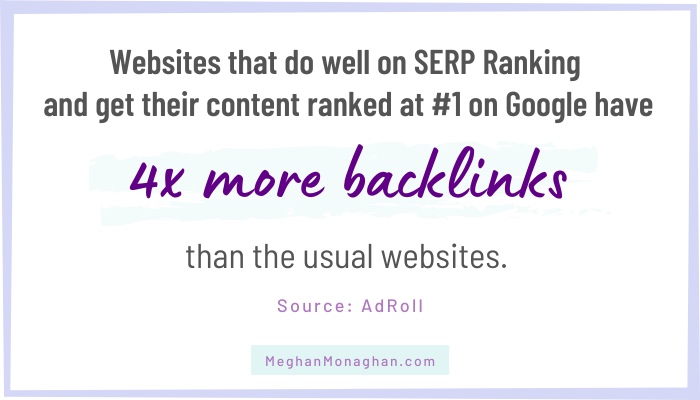
Backlinks are a good metric to track, particularly if one of your content marketing goals is to perform better in search ranking. Since backlinks signify your content’s popularity, they are also good to measure if your goal is to get more traffic. Each backlink has the potential to send more people your way!
With the looming bombardment of AI created blog content, backlinks will be one way to assess which sites have unique content and offer good user experiences.
7) Contacts
Conversions can mean different things to different people. Some consider a conversion a sale, but in the world of marketing, this is not always the case. You’ll discover that conversions at all points in your sales funnel are indicators to measure your content marketing success.
For instance, business coaches, SaaS companies, and service providers often hope that website visitors book a call, whether it be to schedule a demo or make an appointment. So, if your business relies on calls, then you may want to track how many call requests or contact form submissions you receive as a result of your blog.

Also, do you have a live chat system on your website? Increased chat interactions might be another metric for content marketing. Conversations on live chat are early conversions/actions that could lead to sales later.
It may also be worth monitoring the traffic to your ‘Contact Us’ page since internal page tracking will show if the visitor engaged with your content prior to filling out the contact form.
8) Opportunities
Success can come in other forms than a typical sale. Perhaps you’re using your content to boost your influence, authority, and visibility to acquire speaking gigs, interviews, or collaboration and guest post opportunities. Or, maybe you want to attract sponsorships or affiliates. These are trackable things that can be used to evaluate how well your content is supporting your business goals.

When your authority content (aka “Clout Content”) and blogging improve your influence and reputation, people will seek you out. You may notice that things are happening for you!
This was what happened to me with my Smart Bird Social blog. I even had someone contact me to buy my site! They wanted to take advantage of the content and its performance in search to promote their own product.
9) Sales
Finally, here’s a clue that doesn’t require in-depth knowledge of web analytics: sales! Even better, it’s one of the best and most obvious content marketing metrics of all.
Blogging can improve your conversation rate. And, increased sales could indicate that your content strategy is working.
In 2021, Hubspot asked almost 300 consumers if they had “purchased something from a company after reading a blog post from them” and 56% said yes!
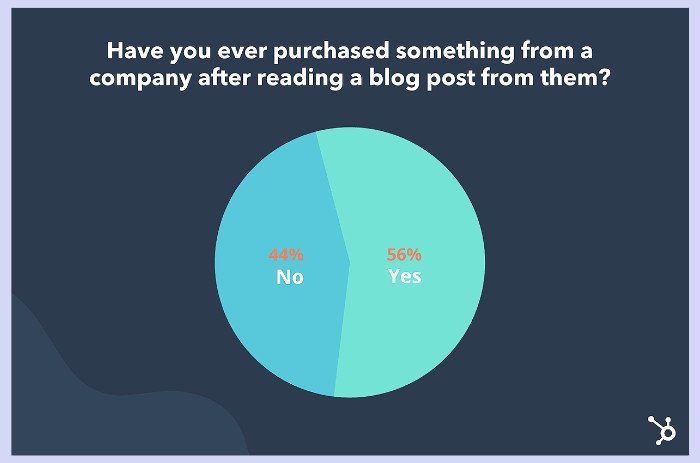
However, did blogging alone make the difference? It’s hard to tell.
Overall, a combination of different types of marketing strategies probably contribute to a boost in sales. Blogging may play a big role, though. As Hubspot pointed out in that post, “blogs can help you sell products in ways that other content types can’t,” and they provide the trust and credibility that lead to purchases.
Perhaps try to incorporate some tracking mechanism into your sales process. You also need to be aware of all of the moving pieces of your marketing campaigns. This way, you’ll know what is contributing to sales and where there is room for improvement. Otherwise, it will be difficult to make correlations between your content and sales upticks.
Content Marketing Metrics Guide Your Blog Strategy, But Start with Goals
Before you focus on content marketing metrics for your blog, you must set goals. That’s the first step! Your blogging goals and business goals impact the metrics you measure.
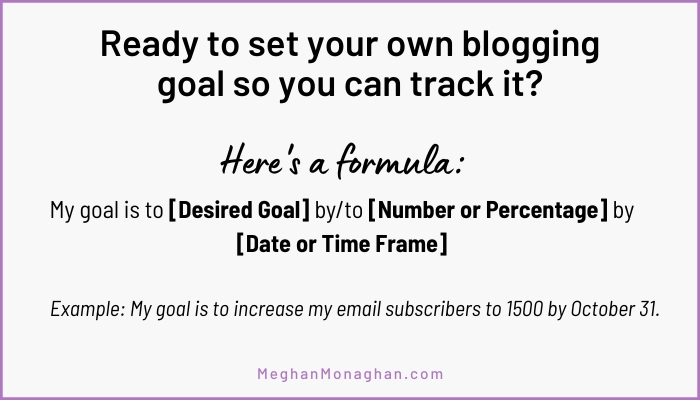
Track only a few metrics to start so that you don’t get overwhelmed. And, make sure to block time on your calendar to analyze your blog’s performance. Otherwise, you’ll never do it! Keeping up with content marketing for your small business requires strategy and planning.
One other important piece to remember: every business is different. The metrics that matter for your business won’t be the same as someone else’s because your blogging goals differ. Let your goals determine your success and measure accordingly.
Once you get used to analyzing your metrics, incorporate the results into any future content creation and content marketing strategy. The awesome part of digital marketing is that you can usually pivot quickly if necessary, modifying your plans to better meet your audience’s preferences.
And, if you need help with creating a content strategy for your blog, then reach out to me or your trusted digital marketing agency. It takes expertise to know what content to publish to perform better in search and to generate more qualified leads!
UPDATED March 1, 2023 | ORIGINALLY PUBLISHED July 19, 2017

More great information Meghan! I am probably only looking at a couple of these.
Hey Bob, appreciate the feedback and compliment, thank you!
I’ve been using Buzz Sumo regularly since you first gave me that tip a few months ago. It’s terrific! Do you use Alexa’s analytics for anything? I notice that what Alexa tells me about my bounce rate is WAY off from what GA says. I’ve been obsessing over analytics a bit lately.
I love Buzzsumo and really miss my paid subscription. That’s great that you’ve been using it, wahoooooo! I haven’t used Alexa for anything. I’ve noticed that the SEO tools all give me different results. Google Analytics is way off from Serpstat, SimilarWeb, SEMRush, Ahrefs, and a few other traffic tools I’ve checked in the past. In fact, I bugged Kristen about it the other day, LOL! Using Buzzsumo, Serpstat (got that on an AppSumo deal), and GA give me a general idea of what’s working in terms of my content. Oh, and I use a GA WordPress plugin that shows me views in my dashboard. Views don’t track time on page of course, but I still consider them to be one metric that signals a hot post versus one that missed that mark.
This is the great scenario! I am sure everyone wants to get high marks on all of these. This is a good time to evaluate.
Nice post. Sometimes I think we’ve got it down pat and other times I think we’ll never know the right thing to share. You look at the analytics and sometimes you need to take into consideration what’s going on in the world…as much as you put numbers on it, there’s always something that skews it all.
Well hell Meggie, you knocked it out of the park again… so much value in this post… and love that you brought up analytics.. because putting content out there that suits you has no value, as it has to resonate with your following… so many things to consider but they are all very worth in… for the search engines, for your consumer, for your website and overall for your business. BOOM
LOL! Love your comments, they always make me feel amazing! Thanks for that. 😉 It’s great that we both blogged about metrics and analytics in the same week, too funny. I try to research what my audience loves and give them more of it. But I’m still a work in progress. You’re so right: content that people don’t care about really doesn’t help your business. Thank you!
Wow, this is such a great post-Meghan, The details are to the point! It amazes me how many marketers overlook the importance of analyzing their metrics. It has helped me especially in improving conversion rates on landing pages and product sales on E-commerce sites.
Thank you, Apolline, appreciate the compliment! You’re a pro and already know about analytics and conversion–yay!
“Let your goals determine your success and measure accordingly.” That is such an important tip and thanks for the reminder that we won’t each look like the other. It is so important to be true to our goals and build on what works best for us!
Yes, so true Reba! Many times we try to mimic what other people are doing, but that fails to incorporate what’s different in our own business. I love the way you said it: we won’t look like each other, so being true to our own goals will best guide us to what analytics to focus upon. Thank you!
This is extremely helpful Meghan. I’ve not been checking any of my analytics lately. I very much appreciate you breaking things down and giving examples. I can see that I need to implement some things here.
Happy to hear the post was helpful! Thanks Joyce!
This was really interesting for me, Meghan. I didn’t know about Buzzsumo and was pleasantly surprised when I just checked my most popular blog posts there, even though it is limited unless you sign up for a plan. My biggest strength is on my blog comments, I would say. I have built a lot of engagement and relationships from there and because of my writing.
It seems like I have a lot of areas I can improve. I’ve been lax on really analyzing my analytics, but it sounds like it would be a good exercise for me to have more insights into who is visiting, when and where they are coming from. Thanks for the prompts and tips as always!
Glad you got some value and tips from the post, Beverley! I used to have full access to Buzzsumo. It’s an awesome tool but pricey. I was lucky because a colleague got an agency account with Buzzsumo, so we could all share the cost among a group of people. Social shares may be weighted more than blog comments when it comes to metrics, but no one really knows for sure. It’s good to have both! You’re not alone in overlooking analytics…I think most people ignore them. I used my metrics to improve a landing page that was converting at 20%; it is now converting at 80%! Hopefully, you can take one tip from the post and incorporate it into your process. Thanks for such a thoughtful comment!